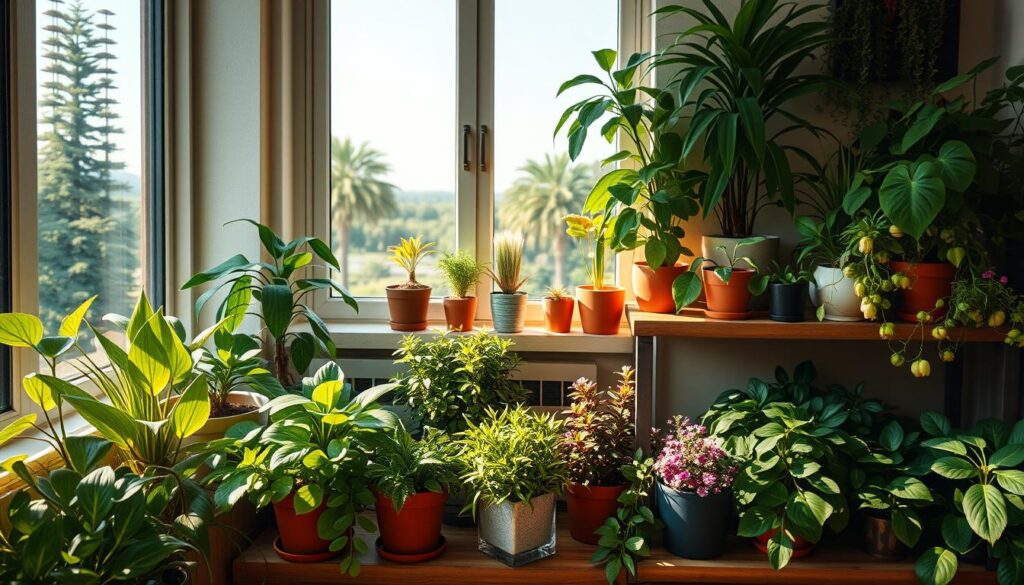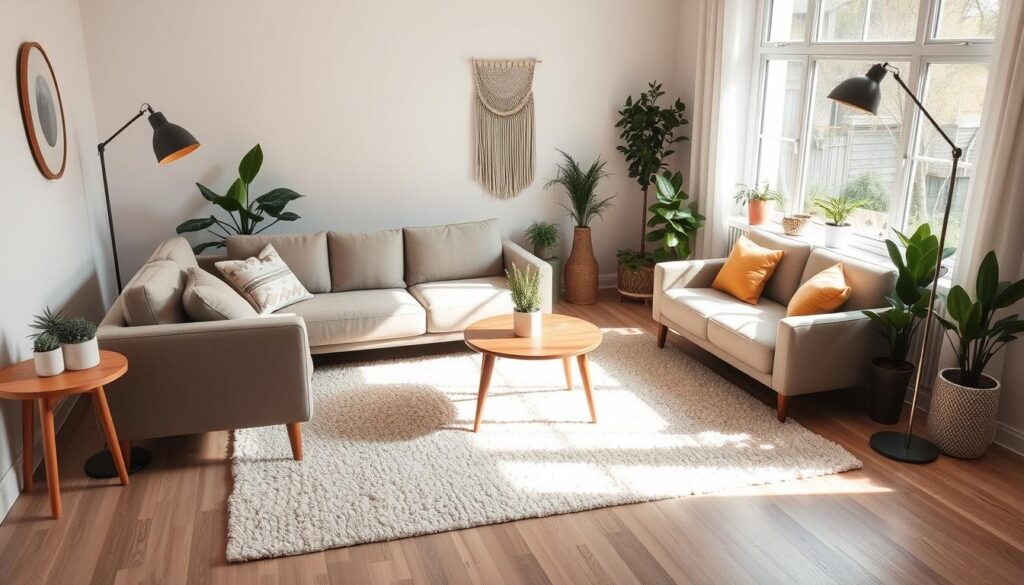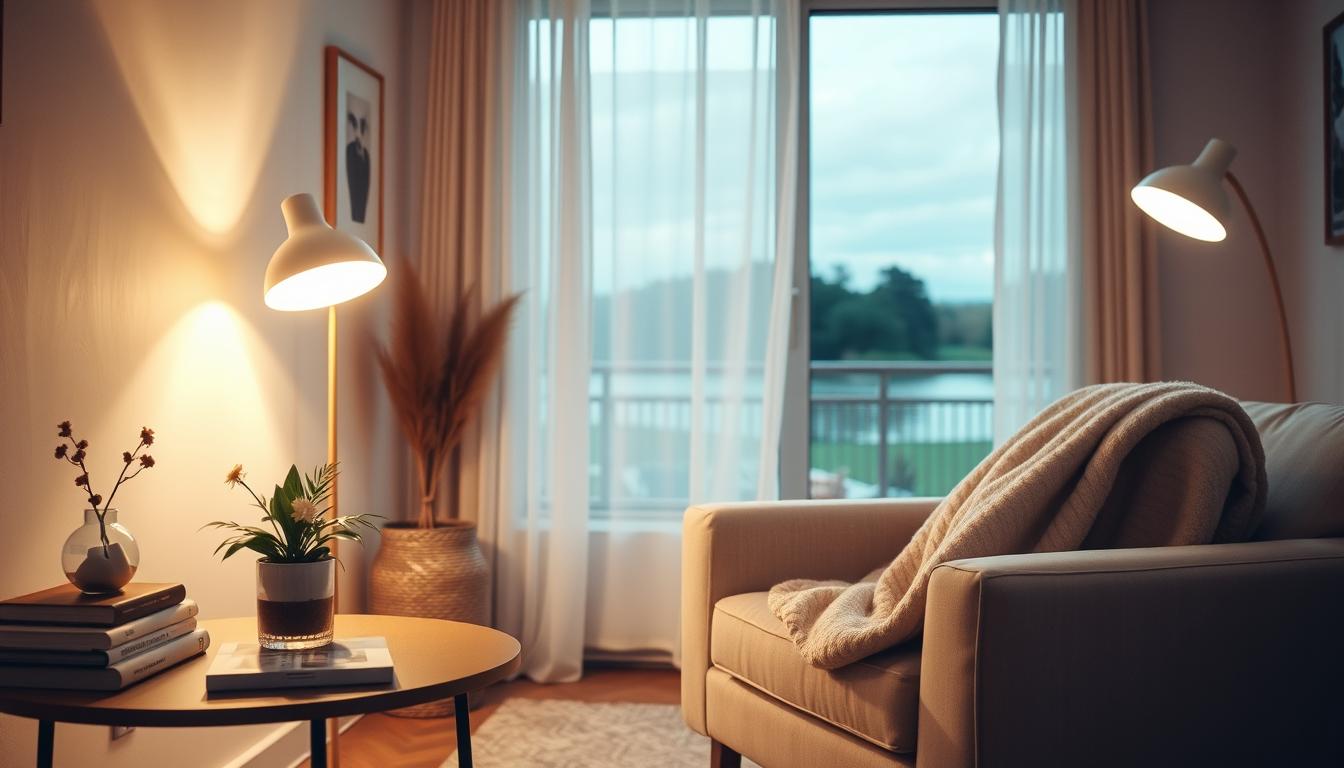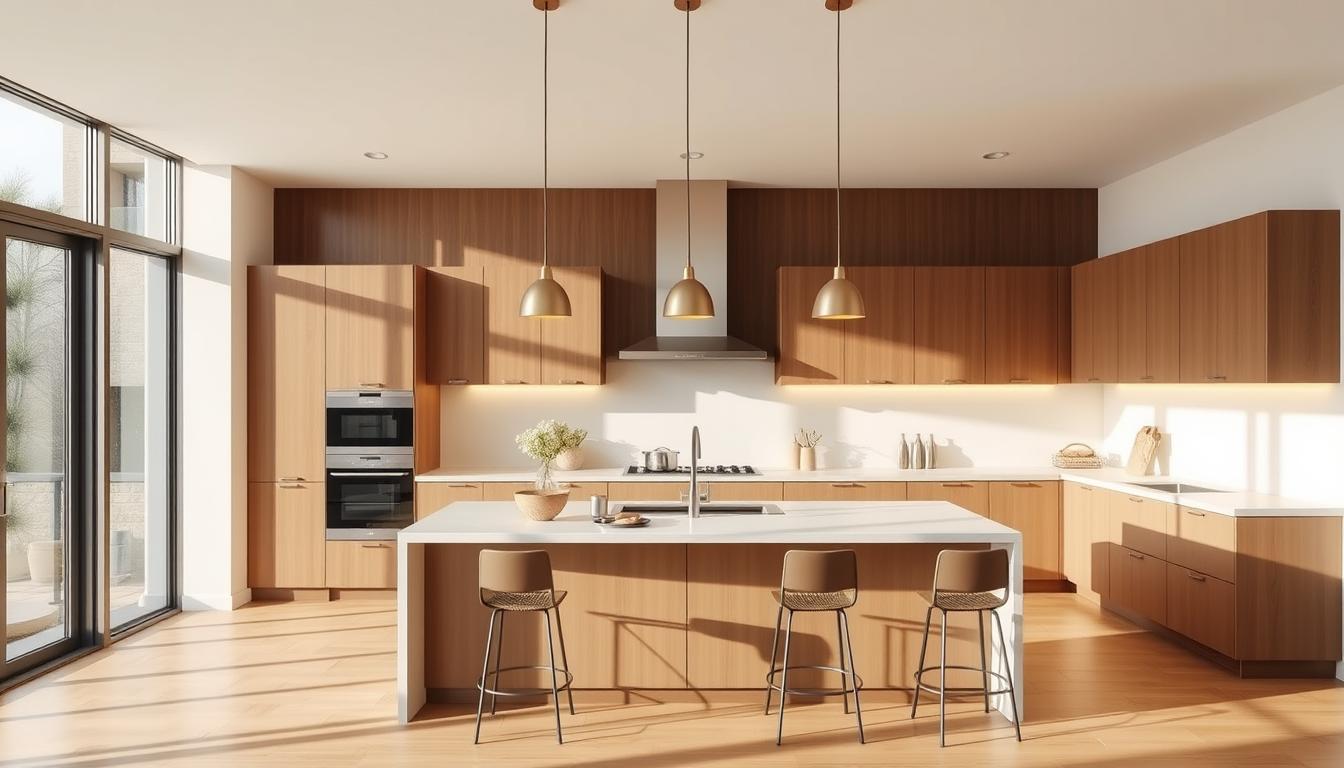Living in a small home doesn’t mean you have to give up style or function. With the right decor and smart tricks, you can make your small space cozy and welcoming.
We’re excited to share our top tips for making the most of your small home. We’ll show you how to pick furniture that does more than one thing. And how to use smart lighting to make your space feel cozy.
Key Takeaways
- Maximize space with multifunctional furniture
- Use smart lighting to create a cozy atmosphere
- Opt for a minimalist decor to avoid clutter
- Utilize vertical space for storage and display
- Select a palette that makes your space feel larger
Maximizing Space with Multifunctional Furniture
Creating a cozy and useful living space in a small home is possible with the right furniture. Look for pieces that do more than one thing to save space.
Choosing the Right Pieces
When picking multifunctional furniture, think about items like storage ottomans or coffee tables with storage. These not only add storage but also help keep your space tidy. For more tiny home design ideas, check out our page on tiny home interior ideas.
For example, a storage ottoman can be a footrest, extra seat, and storage for things like blankets or toys. A murphy bed or sofa bed can also save space during the day.
Creative Storage Solutions
Adding creative storage solutions is key to keeping your space organized. Use hidden compartments, wall-mounted shelves, and under-bed storage to keep things tidy.
| Storage Solution | Description | Benefit |
|---|---|---|
| Hidden Compartments | Secret storage areas within furniture | Keeps valuable or personal items secure |
| Wall-Mounted Shelves | Shelves attached to the wall | Saves floor space and adds decorative element |
| Under-Bed Storage | Storage containers or drawers under beds | Utilizes wasted space for storing linens or out-of-season clothes |
By using multifunctional furniture and creative storage, you can make your small home more functional and cozy. Explore different options to find what fits your space best.
Utilizing Vertical Space Effectively
Using vertical space is key to making small homes feel bigger. When there’s little floor space, looking up opens up new storage and decoration options. It also makes rooms look taller and airier.
Smart use of vertical space boosts both function and beauty in small homes. It keeps floors clear and draws the eye upwards. This creates a sense of height and openness.
Installing Shelves Above Furniture
Shelves above furniture are a smart use of vertical space. They offer extra storage for books, decorations, and more. For example, a shelf above a sofa or desk keeps items handy while keeping surfaces tidy.
Choose shelves that match your decor. Floating shelves are great because they look sleek and don’t clutter the space.
| Type of Shelf | Material | Best Use |
|---|---|---|
| Floating Shelves | Wood, Glass | Living rooms, Bedrooms |
| Bracketed Shelves | Metal, Wood | Kitchens, Offices |
| Corner Shelves | Wood, Plastic | Bathrooms, Corners of rooms |
Hanging Decorations and Plants
Hanging decorations and plants are great for vertical space. They add beauty and make rooms lively. Hanging plants also bring nature indoors and improve air quality.
Choose items that fit your style. For a bohemian vibe, try macramé hangers. For something simple, sleek planters work well. Wall-mounted planters make a bold statement.
“The key to making small spaces feel larger is to create a sense of continuity and flow. Utilizing vertical space is crucial in achieving this.”
Adding vertical elements makes small homes feel more welcoming and spacious.
In summary, using vertical space well can greatly improve small homes. Shelves and hanging decorations and plants make living areas more organized and beautiful.
Light Colors for an Expansive Feel
Light colors are key to making small spaces look bigger and more inviting. They reflect light and open up even the smallest areas. To achieve this, use light colors in your home decor.
Painting Walls and Ceilings
Painting walls and ceilings with light colors is a smart move for small rooms. Shades like white, cream, and pale gray reflect light well. Using semi-gloss or high-gloss paint can also help.
Choosing Light Fabrics and Textiles
Light fabrics and textiles also play a big role in making small homes feel open. Choose curtains, bedding, and upholstery in light, airy materials like cotton or linen. Sheer curtains, for example, let in natural light while keeping things private. Light fabrics brighten and warm up your space.
- Cotton: A breathable, natural fabric that works well for bedding and curtains.
- Linen: Known for its lightness and texture, linen is ideal for upholstery and drapes.
- Voile: A semi-sheer fabric that can add a soft, airy feel to rooms.
Smart Lighting Options for Small Areas
In small spaces, the right lighting can make the area seem bigger. It also improves the look of the space. We can use smart lighting to light up the area and add to its feel.
Using layered lighting techniques is a good way to do this. It means mixing different light sources to make the space warm and welcoming. This includes overhead lights, table lamps, and floor lamps.
Layered Lighting Techniques
Layered lighting adds depth and interest to a room. It works by:
- Using overhead lighting as the main light source
- Adding table lamps or floor lamps for focused light
- Using string lights or fairy lights for a soft glow
This way, we can make a cozy and bright space that feels bigger than it is.
Using Mirrors to Reflect Light
Another smart trick is to use mirrors to reflect light. Mirrors placed opposite windows or lights can make the room brighter and more open.
This method also adds beauty to the space. We can pick from many mirror shapes and sizes to match our decor.
By using these smart lighting options, we can make even the smallest areas feel welcoming and spacious.
Open Floor Plans: Creating Flow
Open floor plans are great for small homes. They make the space feel bigger and more open. This is because they remove walls, creating a sense of continuity.
To get the most out of an open floor plan, it’s key to define different areas. Rugs are a good way to do this. They can mark off zones like a living area and a dining area.
Defining Areas with Rugs
Rugs add warmth and texture to your space. They also help separate different areas. Here are some tips for using rugs:
- Choose rugs that match your home’s color scheme and style.
- Use a big rug for the main living area and a smaller one for the dining area.
- Layer rugs for more depth and interest.
Using Furniture as Dividers
Furniture can also help divide an open floor plan. By placing furniture smartly, you can create separate zones without walls.
For instance, a console table or bookshelf can separate the living area from the dining area. A sofa can also mark the boundary between the living room and the rest of the space.
By using these elements, you can make a functional and cozy living space. It will make the most of your open floor plan.
Incorporating Natural Elements
Small homes can feel warmer and fresher with natural elements. These elements help create a cozy and calming space.
“As noted by interior designers, bringing the outdoors in can significantly enhance the ambiance of a home.” – A statement often echoed in home decor discussions.
Indoor Plants for Freshness
Indoor plants clean the air and add greenery to small homes. Some top picks include snake plants, spider plants, and peace lilies. They’re easy to care for and work well in different light conditions.

Natural Light and Window Treatments
Getting more natural light makes small homes feel bigger. Sheer curtains or blinds help control light while keeping things private. It’s key to keep windows clear for better light flow.
As
“The right window treatments can make a significant difference in the overall feel of a room.”
Choosing the right window treatments is important. They should match the natural light and decor of your home.
Personalizing Small Spaces
To make a small home truly yours, add unique decorative elements that show your personality and style. Personalizing small spaces is key to making them feel like home.
Displaying art and personal items is a great way to personalize your space. This can include family photos, collectibles, or artwork that speaks to you. By showcasing these items, you can add a personal touch to your home.
Displaying Art and Personal Items
When displaying personal items, think about the look you want to achieve. You can group similar items together for a cohesive look or mix them for an eclectic feel. Using a mix of frame styles and sizes can add visual interest to your walls.
Here are some tips for displaying art and personal items effectively:
- Choose items that hold sentimental value or personal significance.
- Experiment with different arrangements to find a layout that works for you.
- Consider the color palette and style of your existing decor.
As the saying goes, “The home should be the workplace of the family.” By displaying personal items, you can make your space feel more like home.
“The home should be the workplace of the family.”
DIY Projects for Unique Touches
Engaging in DIY projects is another excellent way to personalize your small space. This can include crafting, upcycling, or repurposing items to create unique decorative pieces. Not only does this add a personal touch, but it also helps reduce waste.
Some popular DIY projects for small spaces include:
| Project | Description | Skill Level |
|---|---|---|
| Photo Gallery Wall | Create a collage of your favorite memories. | Easy |
| Upcycled Planters | Turn old containers into planters for your plants. | Moderate |
| Customized Shelves | Design and build shelves that fit your space perfectly. | Challenging |
By incorporating DIY projects and personal items, you can create a space that truly reflects your personality and style.
Creative Layouts for Functionality
A creative layout can turn a small home into a cozy and efficient space. By arranging furniture wisely and using every corner, you can make a living area that’s both functional and comfy.
Arranging Furniture for Comfort
It’s important to arrange furniture for comfort and conversation. We suggest creating cozy reading nooks or areas for chatting. This encourages relaxation and socializing. Also, think about how people will move around your home and arrange furniture to make it easy.

Using furniture that does more than one thing is also smart. For example, storage ottomans or nesting tables can help keep your home tidy and organized. These pieces are useful and save space.
Utilizing Nooks and Corners
Using nooks and corners well can really improve your small home’s functionality. Corner shelves or a corner desk can make the most of unused space. These spots are great for a home office or a cozy reading area.
Also, baskets or bins in corners can add extra storage. They’re perfect for keeping things like linens, toys, or kitchen tools out of the way but still easy to find.
Color Schemes that Work Wonders
A good color scheme can change how small homes feel. The right colors can make your space look bigger and feel welcoming.
Using monochromatic palettes is a smart choice. It means using different shades of the same color. This makes your home look calm and connected, perfect for small spaces. For example, blues from light to navy can create a peaceful and beautiful setting.
Monochromatic Palettes
Monochromatic color schemes are not just pretty; they also make your home seem bigger. By using different shades of one color, you get a clean look. This makes your home feel more open. Here are some good points about monochromatic palettes:
- Creates a sense of continuity and flow
- Enhances the feeling of spaciousness
- Simplifies decorating decisions
Accents That Pop
While monochromatic palettes are great, adding accents that pop brings life and personality to your space. These can be bold pillows, colorful rugs, or vibrant artwork. The trick is to balance your main color with these accents.
For more ideas on choosing the best colors for your home, see our guide on selecting the perfect interior color schemes.
Here are some tips for using accents well:
- Choose accents that complement your base color
- Limit your accents to a few statement pieces to avoid clutter
- Experiment with different textures and patterns to add depth
Adapting to Seasonal Changes
As the seasons change, our homes should too. This keeps them feeling fresh and updated. By using a few simple strategies, you can refresh your space to match the season’s mood and look.
Flexible Decor for Different Times of Year
Using flexible decor is key to adapting to seasonal changes. This includes seasonal throw pillows, holiday decorations, and other items that reflect the current season. For example, in spring, add bright colors and floral patterns. In winter, switch to warmer tones and cozy textures.
Here are some ideas for flexible decor:
- Seasonal throw pillows and blankets
- Holiday decorations
- Seasonal artwork or prints
- Decorative vases or centerpieces that reflect the season
Easy Swaps for a Fresh Look
Making easy swaps is another effective way to give your home a fresh look. This can be as simple as switching out rugs, updating lighting fixtures, or rearranging your furniture. These small changes can make a big impact and keep your home feeling current.
| Season | Easy Swaps |
|---|---|
| Spring | Lighten up with sheer curtains, add a fresh rug |
| Summer | Use bright colors, add outdoor decor |
| Autumn | Warm up with cozy throw blankets, add seasonal decor |
| Winter | Cozy up with warm lighting, add holiday decorations |
By incorporating these strategies, you can keep your small home feeling fresh and updated all year. Whether you make small changes or completely overhaul your decor, adapting to seasonal changes is a great way to keep your space feeling current and inviting.
Designing for Comfort and Coziness
Making your small home warm and inviting is key. We do this by adding cozy touches. Cushions and throws bring warmth and texture to your space.
Cozy Accents
Cushions and throws are not just useful. They also make your furniture look good. Pick materials that feel soft and look nice. For example, plush rugs and soft blankets make your space cozy.
Texture and Pattern
When you design for comfort, think about textures and patterns. Mixing different textures like velvet, linen, and cotton adds depth. Patterns, from simple stripes to complex designs, also help create coziness.
By focusing on comfort and coziness, you can make your living space welcoming. Adding cushions and throws makes it a place you’ll enjoy being in.



